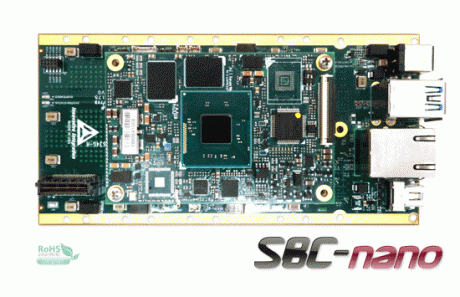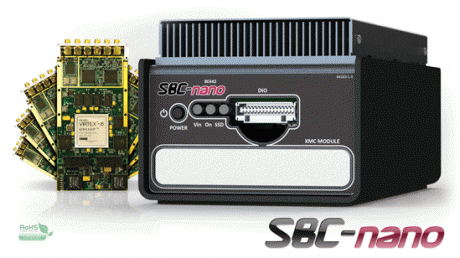
Features
- Combines an industry standard COM Express CPU module with XMC IO module in a compact, stand-alone design
- Atom CPU with XMC site
- Powerful performance using Intel-based CPU core via COM Express
- Small form factor: 150 x 75 mm
- Rugged, stand-alone operation
- Able to operate headless
- Runs Windows or Linux applications including RTOS variants
- Configurable IO uses standard XMC IO modules —add anything from RF receivers to industrial control modules
- PCI Express IO site (VITA 42.3) delivers >1600 MB/s to CPU memory
- Supports Innovative X3, X5 and X6 IO module features for private data channels, triggering and timing
- USB 3.0/2.0 x1, USB 2.0 x2, SATA x2, mini DisplayPort
- Optional connectivity via 1 Gb Ethernet link
- Boots from 32 GB eMMC
- On-board XMC FPGA JTAG programmer
- 6-14V DC operation
- Boots from SATA3 HDD or SSD Optional GPS module support AC or 8-36V DC operation
- AC or 9-18V DC operation
Applications
- Embedded Instrumentation
- Remote, Autonomous IO
- Mobile Instrumentation
- Distributed Data Acquisition
Useful resources on Youtube
Overview
The SBC-Nano combines a Windows/Linux compatible embedded PC with a XMC IO module and supporting peripherals to create a customizable instrument for a wide variety of applications.
The embedded PC architecture is Windows/Linux compatible, able to run the same applications as a desktop computer. The COM Express CPU module is a PC on a module and provides the computing engine, available with four low power Atom cores for ultimate computing power.
The COM Express module provides the PCI Express interface that links the XMC module to the CPU. The XMC module behaves identically to PCI Express add-in cards within a PC and are software compatible with PC applications. The PCI Express link tightly couples the CPU to the XMC modules and outperforms previous generation systems by 2 to 4 times. Data transfer rates between the XMC module and CPU memory occur at speeds of upto 1600 MB/s.
SBC-nano provides familiar PC interfaces for expansion and connectivity: Ethernet, USB ports, and SATA SSD. Multiple SBC-nano’s may be connected into a mesh using the optional 1 Gb ethernet port for high performance IO supporting up to ~100 MB/s transfer rates to external devices such as other eInstruments>
The mini DisplayPort video port and USB keyboard/mouse make operating the SBC-nano just like any PC. Standard PC screens supporting resolutions up to 1280×780 are supported. “Headless” operation is also supported for truly embedded applications without a keyboard/monitor/mouse attached. In the headless mode, the SBC-nano can be remotely controlled and accessed over Ethernet or via remote protocols such as RDP or VNC.
A single XMC IO module site enables the SBC-nano to be configured with a wide variety of IO modules. The XMC site is for PCI Express mezzanine cards conforming to the VITA 42.3 standard, which are 75 x 150 mm modules (IEEE 1386). Each installed module must employ a suitable heat spreader to conduct heat to the thermal rails running the long edge of the SBC-nano connected to a cold-plate within the system. Innovative offers three lines of XMC IO modules: the X3, X6 and the XU families. These module families offer a range of analog performance mated to high performance FPGA computing cores, with the XU family featuring Kintex Ultrascale, the X6 family featuring the Xilinx Virtex 6 and the X3 using the Xilinx Spartan 3 family. Innovative’s Velocia architecture data packet system allows these modules to stream data continuously to system memory at rates up to 1.6 GB/s – making the SBC-nano well suited for data logging and playback functions.




